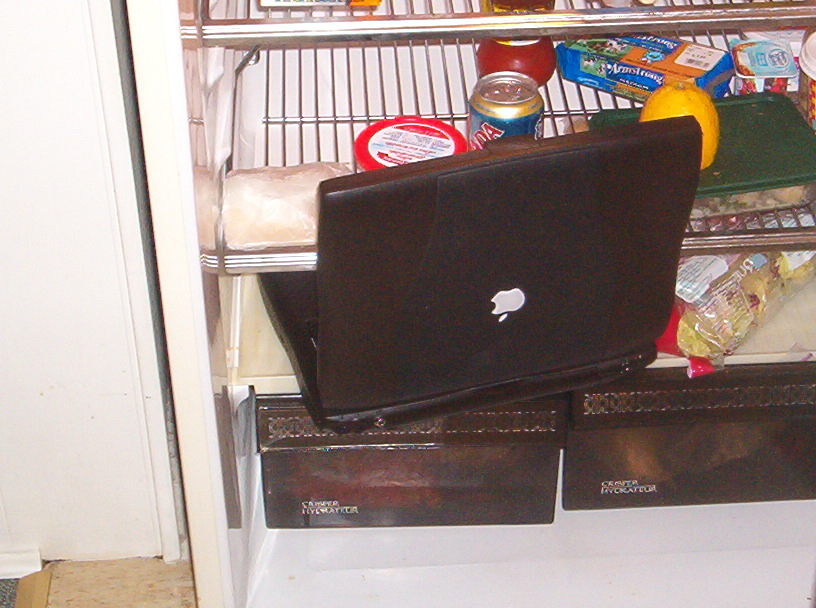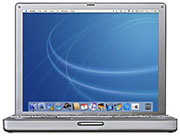Article #2
Delayed-Onset 12” AlBook “WOW”
Factor
By Ryan Vetter
August 9, 2003
I detailed in a recent article (Attraction to Retro-PowerBooks), that
there was about a 4 year span where the Apple user was unable to purchase
a small, then modern, new portable laptop (i.e. PowerBook or iBook). The
PowerBooks and iBooks of that time (about 1997-late 2000) were in no way
as compact and thus as portable as their pre-1996 predecessors. At that
time, for the Apple user that wanted the latest in computing power, in
addition to wanting a PowerBook or iBook with similar dimensions as compared
to pre-1996 PowerBooks, they had no options.
The 12” AlBook, and of course, the 12” iBook, is the solution.
But for the Apple user who demands both the most compact and the latest
in computing power, the 12” AlBook, rather than the 12” iBook,
is the choice. Lets take a look at the specs of the 12” iBook and
the 12” AlBook.
Further to the above specs, the 12” AlBook is furnished with 2 USB
ports (12-mbps), 4x AGP 2D/3D graphics acceleration, a slot loading optical
Combo drive (CD-R 24x, CD-RW 10x, and CD-ROM 24x) with the option of the
SuperDrive (DVD-R 1 x, CD-RW 4x, CD-R 8x, CD-ROM 24x, and DVD-ROM 8x),
Airport Extreme ready (54 mbps), 133 Mhz bus, built in mic with audio
input and output, and 1 3rd midrange speaker.
The iBook has 2 USB ports (12-mbps), 2x AGP 2D/3D graphics acceleration,
tray loading optical drive (CD-ROM 24x) or a tray loading Combo drive
(CD-R 24x, CD-RW 10x, and CD-ROM 24x), Airport ready (11 mbps), 100 Mhz
bus, and a built in mic with no audio input (includes audio output). Both
machines have a 640 MB RAM ceiling and both the 12” AlBook and the
12” iBook do not support DVI and ADC monitors nor gigabit Ethernet.
However, this is not entirely true. There is a solution in this department
for the 12" AlBook. For an extra $299, one can add DVI and ADC support
to the 12" AlBook with a Gefon Ex-tend-it VGA-to-ADC conversion box.
Sounds like a name Philip K. Dick, former American science fiction writer,
would have come up with.
Both machines are most impressive in terms of features and power, but,
as can be seen, the 12” AlBook offers the user more powerful features,
when compared to the iBook, like the Airport Extreme support (54 mbps),
a better graphics chip with double the AGP, 33 Mhz faster bus, better
sound from the speakers?, nicer keyboard, faster RAM, and the option of
the SuperDrive so you can burn not only CD’s, but DVD’s too,
and audio line-in. Bear in mind that SuperDrive owners take a hit in CD-RW
(4x) and CD-R (8x) speeds.
Now, for the clincher. The 12” AlBook, compared to the 12”
iBook, is 0.3 lbs lighter, 0.17” less in height, 0.30” less
in width, and 0.46” less in depth. Moreover, it is constructed with
99.5% pure Aluminum as opposed to the iBooks impact-resistant polycarbonate
plastic casing with a magnesium frame. I am not sure if Aluminum is better
than the iBooks casing material, in fact, the 12” AlBook might even,
finally, lose points in this department, as Aluminum is a good conductor
of heat, and one may feel more heat from the 12" AlBook, particulary
when placed on ones lap, than the iBook.
The heat battle seems to be becoming
more of an issue now with the advent of using Aluminum and Titanium shells
on the PowerBook line. In fact, there are some rather elaborate cooling
stands available for PowerBooks emerging. But, the 12" AlBook and
the like are not alone in respect to getting hot; take my Wallstreet pictured
below. I just throw it in the fridge when it gets too hot.

Additionally, the 12” AlBook most certainly loses points, when compared
to the 12” iBook, for its price tag, which is $600 or $800 more
than the base 12” iBook and $300 or $500 more than the loaded 12”
iBook.
What does all this extra money and under-the-hood features that the 12”
AlBook brings with it give back to the user? MacWorld Benchmarks suggest
quite a bit. The 12” AlBook scored 114 on Speedmark 3.2, whereas
the G3 800 Mhz iBook scored 74. The reference point in the scoring was
an Emac 700 Mhz G4 computer (100). Specifically, the 12” AlBook
was at least twice as fast as the iBook 800 Mhz when, for example, encoding
MP3’s in iTunes or rendering in iMovie. Moreover, the Quake III
frame test revealed that the 12” AlBook was able to display about
20 more frames (53.9) than the G3 800 Mhz iBook (36.5).
In closing, the 12” AlBook is being called the smallest PowerBook
built. It is not. For example, the trusty PowerBook 2400c (see picture
below) is, although .02” higher, is 0.40” less in width and
0.10” less in depth than the 12" AlBook. In addition, the PowerBook
2400c has an infrared port and 2 PC Card slots, something the 12”
AlBook lacks.

Of course, the SuperDrive, the G4,
etc., more than make up for these two omissions.
The 12” AlBook … Smart. PBRM |
